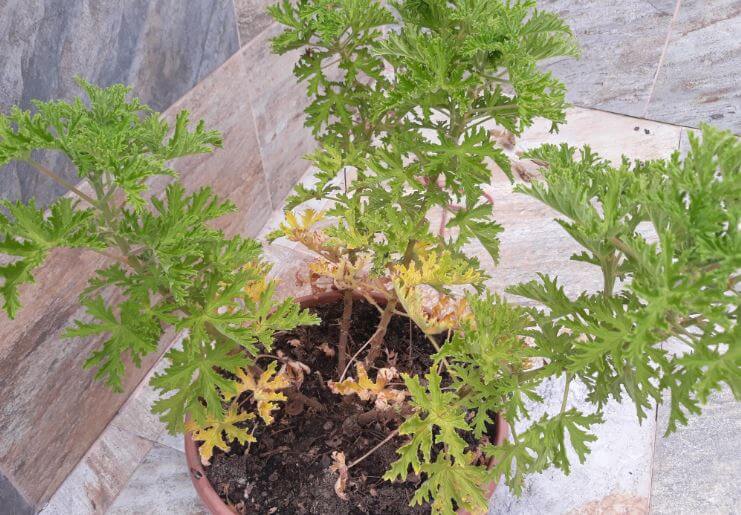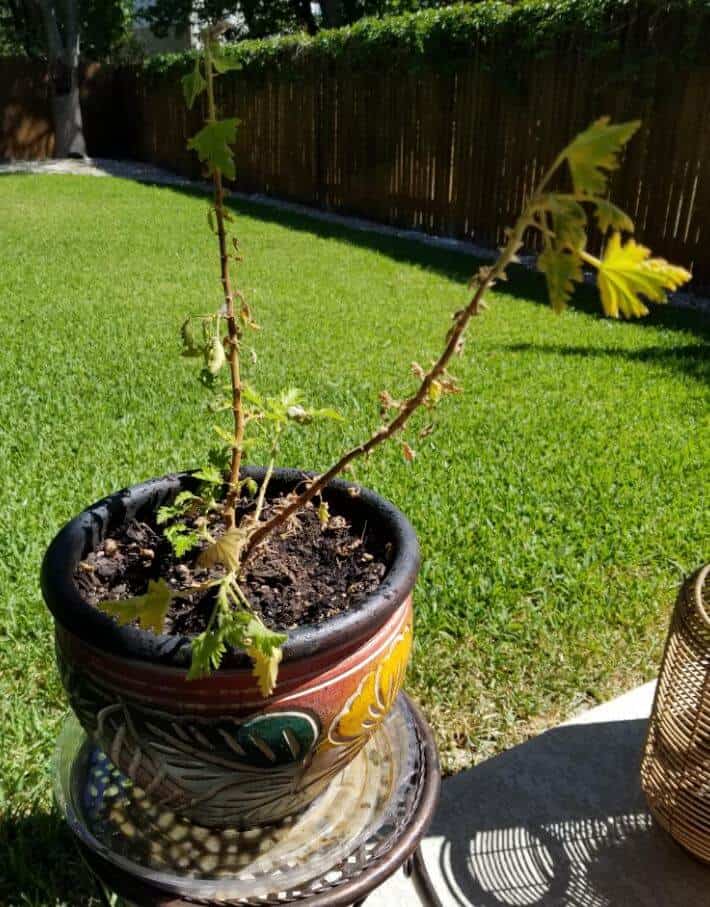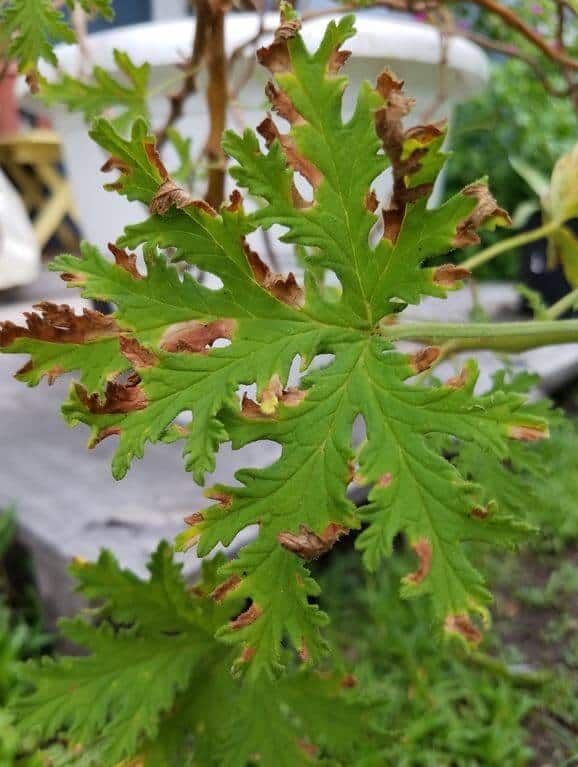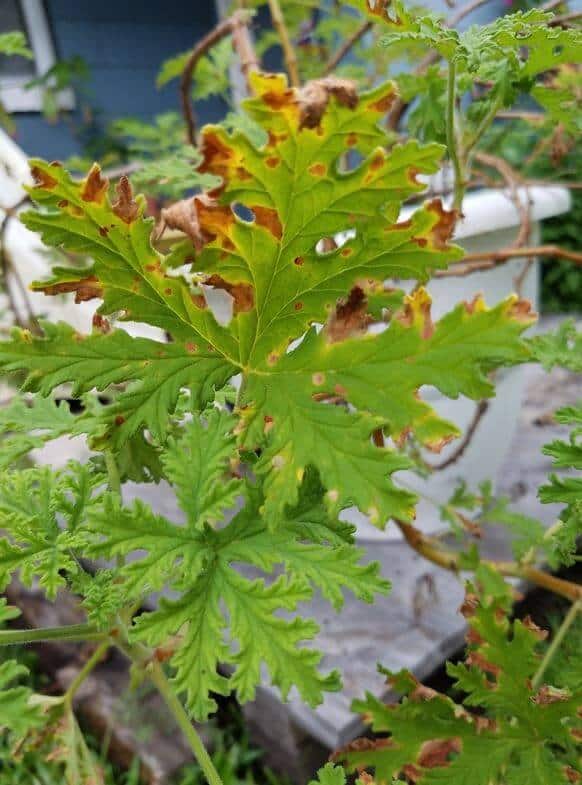Last Updated on July 13, 2023 by a Friendly Gardener
Popular for their effect on mosquitoes, citronella plants can occasionally wilt and change color. This can be worrying, and there can be a variety of causes. It’s important to identify the cause to fix the problem.
Why Is My Citronella Plant Turning Brown?

There are a variety of factors that can cause a citronella plant to turn brown. Common causes include:
- Excessive sunlight
- Inadequate sunlight
- Overwatering
- Underwatering
- Poor drainage
- Poor Soil
- A rootbound plant
Excessive Sunlight

The citronella’s foliage contains oil, so it is sensitive to sunlight and heat. When this plant receives too much sunlight, especially full sun exposure, the leaves can begin to dry out, turn brown, and feel crispy to the touch. While citronella plants do best with approximately six hours of sunlight daily, they will need some shade in the afternoon.
What to do
If you feel that your plant is turning brown because it is getting too much sunlight, move your plant or consider placing taller plants nearby to create some partial shade.
Inadequate Sunlight
Citronella foliage can also turn brown because it does not receive enough sunlight. Without adequate sunlight, plants are not able to produce adequate chlorophyll, so the leaves will lose their color, potentially turn brown and go limp. Wilting leaves can be a sign of too little light as is legginess. When plants appear leggy or reach toward a light source, this is generally an indication of too little light. While citronella plants do not need huge amounts of sunlight, they do need light to survive and thrive.
What to do
If your plant is showing symptoms of not receiving enough sunlight, place it closer to a window or use a grow light. Grow lights can provide necessary light without the risk of burning foliage. Grow lights are a great solution for dark offices or homes.
Overwatering

Citronella plants prefer drier soil beds. They will not thrive if left sitting in water or soggy soil. Foliage will begin to fade, brown spots may appear, and foliage will fail. The root systems of citronella plants contain ample amounts of water, so they do not need overly moist soil, so they are at risk of overwatering.
What to do
Poke the soil bed with your finger to check moisture levels. If the soil bed feels dry, then water it. If it still feels a bit damp, wait before giving it a drink.
Underwatering

Underwatering can cause foliage to turn brown and shrivel. If you water sparingly or mist the plant’s soil surface, a sufficient amount of water might not reach the root system.
What to do
If you are worried about underwatering, do a soil soak and let all the excess water drain from the plant’s pot. In this way, you will ensure that water reaches the roots.
Poor Drainage
Poor drainage can cause the same problems as overwatering. You will need a loose well-draining soil mix and a pot that has a decent number of drainage holes. Consider where the water goes if the container doesn’t have drainage holes. Citronella plants will not survive without drainage holes in their pot.
What to do
Transplant your citronella into a new pot with drainage holes and place it in a decorative pot or saucer. Even with a saucer, do not leave the plant sitting in excess water. You can use the same pot, just make sure to drill some drainage holes in the bottom.
Poor Soil

Soil quality is also a consideration. Healthy soil will sustain ecosystems that in turn sustain plant life. Soils that are depleted of organic matter or compacted can create health issues for your plant. It’s always a good idea to test soil for pH levels and organic matter levels. Soil quality can be improved by amending it with organic matter. Citronella plants prefer a soil pH measuring between 5.8 and 6.3.
What to do
Tightly packed soil will not drain well, and your plant may have trouble growing. With tightly compacted soil, water may tend to sit on the soil’s surface rather than soaking the soil. If this is the case, you may want to attempt to loosen the soil using a gardening tool or fork, or better yet, repot your plant in fresh potting soil. Select a loose sandy loamy potting soil blend to ensure adequate drainage.
A Root-Bound Citronella Plant
Sometimes, citronella plants outgrow their containers. Citronella leaves turning brown may be due to the plant being stressed. If the root system does not have room to spread, roots will coil and bind around each other impeding the system to absorb sufficient water and nutrients.
What to do
If there are no other apparent issues with your plant but the foliage is still turning brown, remove your citronella plant from its container and verify if it appears to be root-bound. If you see that your plant has run out of pot space, repot it with fresh soil in a new container that is a size or two larger.
In Conclusion
When citronella plants develop brown foliage or brown patches, you need to verify your watering routine for both overwatering and underwatering as well as drainage efficacy. If watering and drainage do not appear to be the issue, consider the amount of sun exposure. If the environment and care routine appears to be proper, check the root system for inadequate space. A new pot with drainage holes and fresh, loose, well-draining sandy loamy soil will do wonders for your plant and you should notice new, reinvigorated green growth.

